Andalucia: Granada, Cordoba, y Sevilla
To the south we go. So, our second puente was the cause of All Saints' Day, I believe a national holiday here in Spain. It was a wednesday, and becuase we don't have Friday classes to begin with, our Program decided to give us off the Thursday in between as well.
Thus, a group of 5 of us left Tuesday afternoon for our first city of the trip, Granada. Thankfully, this trip featured two flights and a high-speed train, with only one bus. So, we got to Granada in the evening, and found our way to the city. We soon discovered, though, that no one had written down the address of the hostel. When we got there, we assumed we'd have no problem finding it, as it was a very popular hostel. However, to our utter amazement, the hostel was not in the phone book, the city book of hotels, or of hostels. How weird, but the ironic thing was that it was named the Oasis Hotel. A man in the tourist booth at the airport had told us a couple locations--he said there were two (obviously he had no idea what he was talking about)--so after a while of searching we stopped at an internet cafe and looked it up again. When we get there, the woman at the door looks at us strangely, even after we informed her we had a reservation. We come to find out our friend had only reserved himself a place in the room, and our other friend thought that he had done the same like he did in Cordoba. Evidently not...Another fun turn of events. So, the very nice hostel woman told us a good area to find hostels, cheap too, and before we even reached that area after leaving, we ran into a hostel. We went up to the office (had to call up from outside, because by that time it was late), and when we went up she offered us a room of four (we were 5 total, so we needed 4 beds) for only 52 euros per night. That's ridiculously cheap, and the room was clean and beds were nice. So it worked out.
We met back up with our other friend and went to look for long-overdue food. In our area, after a quick look, we discovered that the only places that were open were Middle-Eastern kebab places. Wow, was I thankful for those. Amazing goodness, and cheap, too. Let me just say I enjoyed a few more of those before leaving Granada.
Next morning, we had an early reservation for La Alhambra, had to be there before 8:30. What a struggle to find ANYTHING to eat in the morning at that hour, and finally we got a cup of coffee and a pastry while a group of people waited for this one cafe to open.
La Alhambra (http://en.wikipedia.org/wiki/Alhambra) is the old fortress, palace, and mosque area of during Al-Andalus, during the Muslim rule of most of Spain. I'll pause here to comment about the south of Spain. It's radically different from the north of Spain--weather, customs, appearance of people, food. Al-Andalus was a period of about 700 years (the last Muslim stronghold in Spain was Granada, which was taken in 1492, as is commonly known, by Isabel and Ferdinand). The Muslims occupied most of the peninsula, except for this area and one other, so most of Spain has remnants and buildings from Al-Andalus, but because Andalucia is on the Mediterannean, it has much more old Muslim culture, making it a major attraction. Anyway, back to La Alhambra. It's situated up high on a hill, overlooking the city. It's a huge, sprawling complex, which includes great architecture, awesome carvings, and a large garden complex as well. We spent all of morning there, and part of the afternoon, before coming down the hill to find some food.
That night, after dinner at the Oasis Hostel (cheap and good, surprisingly), we made our way around, and stopped at an Arabic restaurant-type deal with belly-dancing. The belly-dancing was actually quite good, just not that long of a show.
The next day, we stayed in town to catch some of its sights, before having to leave in the afternoon for Cordoba. The first stop: the Royal Chapel. It was a nice church in which Isabella and Ferdinand are intombed, with an amazing piece behind the altar. The place is dripping in gold (I know, a shocker for this period in Spain). Basically, after that, we just walked around the city, looking in some shops, and poking around stores that are particular to the region. The sad thing is that so many stores are devoted to tourism, and thus sell the same ol' crap. We were going to head to the the Cathedral, but like so much in Spain, it was closed during the siesta, and we had to head out shortly after four pm. So, it wasn't worth the entrance price for 15 minutes.
Bus ride to Granada was okay. One thing I have to comment tho: shortly into the trip, I looked out the window and saw fields of olive trees. What a wonderful sight to see, olive trees everywhere, right up to the highway. Then around the next turn, in all directions I looked, all I could see was olive trees to the horizon. No joke. That was particularly amazing. Such a different place from home, and such a beautiful sight. One more incidences like that on this ride, too: we were approaching a small down when the bus took a quick halt. I looked up, to the right, and saw a flock of sheep crossing the road. I don't know why it struck me, but it was just a cool thing to think about at the time.
We arrived in Cordoba that night, and this time found our way to the hostel with enough beds for everyone. The hostel manager told us a place to get some dinner "casera" style, home-cooked, esentially. Good gazpacho, quite an Andalucian treat. The hostel guy also recommended an area to find some young people and some bars, so we wandered in that direction. Ran into their central plaza, very nice, and then into something which shocked the hell out of me. We turn the corner and out shoot up a huge Ancient Roman column structure. WOW. That's not something you get every day. It absolutely awed me, a structure from the 1st century AD, rising out of a modern city. We took some time gazing at it, and a great thing I remarked upon was how it's completely bound of by a modern fence. No one can get it, and initially it's frustrating, but then you realize how great it will be preserved this way. More places should follow this example. Had a bad Amstel and a bad Guinness at a bad jazz club, and then we went back and went to sleep.
Next day, to the Mezquita (http://en.wikipedia.org/wiki/Mezquita). So, basically, Cordoba was the headquarters and capital of Al-Andalus for a couple-hundred years at its peak, and the Mezquita was the largest and most prestigious mosque of its reign. However, when the Christians took over at the end of the 15th century, they converted the mosque into a cathedral. yes, i said converted. they didn't knock it down or even tear it apart but inserted all the forms of a cathedral right into the mosque, even covering the minaret with a bell tower. in fact, the Muslims did the same thing when they took over at the beginning of Al-Andalus, incorporating parts of the Visigothic cathedral into their mosque. Let me say, it was one of the highlights of this semester. I can't even express what an amazing place it is, not just for the clash of cultures but for the combination of cultures. The south of Spain features so much of this, as it was inhabited by many different cultures, but the Mezquita of Cordoba is such a powerful statement of this fact. The entire outside and most of the interior architecture is Moorish, but around all sides on the inside are small chapels, common to old cathedrals. Then, in the middle out of nowhere comes the dome and high altar and all kinds of Christian sculpture and imagery.
That was the highlight of Cordoba besides the rest of the city itself. It was just such a picaresque small city/town that in my opinion so personified the south of Spain. We visited an old Arab bath that day, as well, along with just wandering through the city.
We took a 5 o'clock train to Sevilla, a wonderful high-speed train that took 45 mins instead of a long, nauseating bus ride. Get to Sevilla, find our hotel--which, I must say, was QUITE different than the pictures they showed on the internet--and then went out exploring. We were waiting for this tapas bar, which the hotel people had said was very good and very cheap, but we could only wait so long, as we were gonna go to a "flamenco-esque" show quite a walk away. So, we ended up leaving and grabbing some bocadillos on the way. The show was good, but the problem was that there was nowhere to sit and there were way too many people there to begin with, and my back was not holding out from the day nor was my stamina to stay awake. Let's just say, we left and slept very well that night.
Next day, we started out with the Cathedral. Now, coming from the "Cathedral" of Cordoba (aka la Mezquita, which is now entitled the Cathedral), other churches were gonna have a lot to live up to. But the cathedral of Sevilla was ready for me. It’s technically the largest cathedral in square-footage in the world, and it’s up there with St. Paul’s in London and St. Peter’s in Rome as the three largest churches in Europe. An amazing place, I must say, it was. You can walk up its bell-tower, which looks over the city. Many can view this church as overly gaudy and unnecessary, but it's, at the least, interesting to consider why it was built like this: basically to show Christian power over the Moors. The Catholic monarchs wanted to demonstrate their newly-united power and build the lardest church in the world (well, almost).
After that, we went to the old Moorish Royal Palace and gardens. More great architecture and carvings, with a tremendous garden. we ran into two peacocks just strolling around. Just a weird thing, I guess, in my opinion. That peacocks were just hangin out free. I've never seen anything like it before. After that, we headed toward Plaza Espana, which is a popular spot to just walk and chill out. It features, around its arc, little bench/alcove areas, with one dedicated to each province of Spain. We found Vizcaya, our home province, and took some pictures. It had tiles describing pictorially Pais Vasco's most famous attributes.
That evening, we went to a real flamenco show, which was well-worth the money (didn't hit the wallet THAT much). It was comprised of four performers: a guitarrist, a singer, and two dancers of each sex. They were all very good, and although it catered to tourists, it was well-worth it. An interesting thing from the point of view of a non-native speaker living in Spain is that they had people like us working for them. They appeared to be in their early to middle twenties in age and definitely not native speakers, I mean for the ushers and people who explain things to the audience. They didn't even have a native-Spaniard speak the Spanish directions; just an interesting cultural notice of mine.
We went to a strange bar that night to take in some strange drinks, as suggested by the hostel workers. They said you'd never find another place like this again, and they were right. It was a hole-in-the-wall, tiny little establishment, that was decorated in gaudy religious figures and satin curtains and other trinkets. Layered in this stuff; very tough to describe. Another thing: we were the only young people in there, and the place was packed even as we left at 2 am. Full of middle-aged Spaniards. Also, we had to try their specialty, which was the Sangre de Cristo (Christ's blood), composed of cava (sparkling Spanish wine), grenadina, and whiskey. The grenadine obviously gave it its red color, but much to our chagrin the drink was NOT very tasty.
Next day, we had a flight in the early afternoon, so we decided to make the Plaza de Toros our one morning stop. I really enjoyed it a lot; something VERY special to the south of Spain. Another cultural note, though: our tour guide, a native Spanish woman, gave the tour in three languages: Spanish, English, and French. She was very good at all of them, and I couldn't understand why she was a tour guide with that ability. But, extra languages here in Europe isn't as special as it is in the States. We've stumbled upon so many workers in the tourist industry--for example, a crappy hotel by the airport in Paris had numerous workers who were fluent in more than 2 languages--but it still boggles my mind.
I really couldn't understand why so many people make a fuss about Sevilla being such a remarkable city. Out of the three we saw on the trip, it was the one I liked the least. Granted, it's a great place with a lot of wonderful neighborhoods, monuments, and life, but it seemed like it was trying to be too many different things: like a modern, almost-ugly city amongst its beautiful past. Granada, from what I saw, has been able to avoid this modern ugliness. But, in the end, I still enjoyed Sevilla, regardless of my opinion that it's selling out on its Andalusian roots.
Awesome puente to the South of Spain, and we saw sooo many things. So different than Pais Vasco, yet still somewhat the same. That's part of the beauty of Spain; you can see so many different types of people, cuisine, land, tourism industries, and you're still in one country.
Thus, a group of 5 of us left Tuesday afternoon for our first city of the trip, Granada. Thankfully, this trip featured two flights and a high-speed train, with only one bus. So, we got to Granada in the evening, and found our way to the city. We soon discovered, though, that no one had written down the address of the hostel. When we got there, we assumed we'd have no problem finding it, as it was a very popular hostel. However, to our utter amazement, the hostel was not in the phone book, the city book of hotels, or of hostels. How weird, but the ironic thing was that it was named the Oasis Hotel. A man in the tourist booth at the airport had told us a couple locations--he said there were two (obviously he had no idea what he was talking about)--so after a while of searching we stopped at an internet cafe and looked it up again. When we get there, the woman at the door looks at us strangely, even after we informed her we had a reservation. We come to find out our friend had only reserved himself a place in the room, and our other friend thought that he had done the same like he did in Cordoba. Evidently not...Another fun turn of events. So, the very nice hostel woman told us a good area to find hostels, cheap too, and before we even reached that area after leaving, we ran into a hostel. We went up to the office (had to call up from outside, because by that time it was late), and when we went up she offered us a room of four (we were 5 total, so we needed 4 beds) for only 52 euros per night. That's ridiculously cheap, and the room was clean and beds were nice. So it worked out.
We met back up with our other friend and went to look for long-overdue food. In our area, after a quick look, we discovered that the only places that were open were Middle-Eastern kebab places. Wow, was I thankful for those. Amazing goodness, and cheap, too. Let me just say I enjoyed a few more of those before leaving Granada.
Next morning, we had an early reservation for La Alhambra, had to be there before 8:30. What a struggle to find ANYTHING to eat in the morning at that hour, and finally we got a cup of coffee and a pastry while a group of people waited for this one cafe to open.
La Alhambra (http://en.wikipedia.org/wiki/Alhambra) is the old fortress, palace, and mosque area of during Al-Andalus, during the Muslim rule of most of Spain. I'll pause here to comment about the south of Spain. It's radically different from the north of Spain--weather, customs, appearance of people, food. Al-Andalus was a period of about 700 years (the last Muslim stronghold in Spain was Granada, which was taken in 1492, as is commonly known, by Isabel and Ferdinand). The Muslims occupied most of the peninsula, except for this area and one other, so most of Spain has remnants and buildings from Al-Andalus, but because Andalucia is on the Mediterannean, it has much more old Muslim culture, making it a major attraction. Anyway, back to La Alhambra. It's situated up high on a hill, overlooking the city. It's a huge, sprawling complex, which includes great architecture, awesome carvings, and a large garden complex as well. We spent all of morning there, and part of the afternoon, before coming down the hill to find some food.
That night, after dinner at the Oasis Hostel (cheap and good, surprisingly), we made our way around, and stopped at an Arabic restaurant-type deal with belly-dancing. The belly-dancing was actually quite good, just not that long of a show.
The next day, we stayed in town to catch some of its sights, before having to leave in the afternoon for Cordoba. The first stop: the Royal Chapel. It was a nice church in which Isabella and Ferdinand are intombed, with an amazing piece behind the altar. The place is dripping in gold (I know, a shocker for this period in Spain). Basically, after that, we just walked around the city, looking in some shops, and poking around stores that are particular to the region. The sad thing is that so many stores are devoted to tourism, and thus sell the same ol' crap. We were going to head to the the Cathedral, but like so much in Spain, it was closed during the siesta, and we had to head out shortly after four pm. So, it wasn't worth the entrance price for 15 minutes.
Bus ride to Granada was okay. One thing I have to comment tho: shortly into the trip, I looked out the window and saw fields of olive trees. What a wonderful sight to see, olive trees everywhere, right up to the highway. Then around the next turn, in all directions I looked, all I could see was olive trees to the horizon. No joke. That was particularly amazing. Such a different place from home, and such a beautiful sight. One more incidences like that on this ride, too: we were approaching a small down when the bus took a quick halt. I looked up, to the right, and saw a flock of sheep crossing the road. I don't know why it struck me, but it was just a cool thing to think about at the time.
We arrived in Cordoba that night, and this time found our way to the hostel with enough beds for everyone. The hostel manager told us a place to get some dinner "casera" style, home-cooked, esentially. Good gazpacho, quite an Andalucian treat. The hostel guy also recommended an area to find some young people and some bars, so we wandered in that direction. Ran into their central plaza, very nice, and then into something which shocked the hell out of me. We turn the corner and out shoot up a huge Ancient Roman column structure. WOW. That's not something you get every day. It absolutely awed me, a structure from the 1st century AD, rising out of a modern city. We took some time gazing at it, and a great thing I remarked upon was how it's completely bound of by a modern fence. No one can get it, and initially it's frustrating, but then you realize how great it will be preserved this way. More places should follow this example. Had a bad Amstel and a bad Guinness at a bad jazz club, and then we went back and went to sleep.
Next day, to the Mezquita (http://en.wikipedia.org/wiki/Mezquita). So, basically, Cordoba was the headquarters and capital of Al-Andalus for a couple-hundred years at its peak, and the Mezquita was the largest and most prestigious mosque of its reign. However, when the Christians took over at the end of the 15th century, they converted the mosque into a cathedral. yes, i said converted. they didn't knock it down or even tear it apart but inserted all the forms of a cathedral right into the mosque, even covering the minaret with a bell tower. in fact, the Muslims did the same thing when they took over at the beginning of Al-Andalus, incorporating parts of the Visigothic cathedral into their mosque. Let me say, it was one of the highlights of this semester. I can't even express what an amazing place it is, not just for the clash of cultures but for the combination of cultures. The south of Spain features so much of this, as it was inhabited by many different cultures, but the Mezquita of Cordoba is such a powerful statement of this fact. The entire outside and most of the interior architecture is Moorish, but around all sides on the inside are small chapels, common to old cathedrals. Then, in the middle out of nowhere comes the dome and high altar and all kinds of Christian sculpture and imagery.
That was the highlight of Cordoba besides the rest of the city itself. It was just such a picaresque small city/town that in my opinion so personified the south of Spain. We visited an old Arab bath that day, as well, along with just wandering through the city.
We took a 5 o'clock train to Sevilla, a wonderful high-speed train that took 45 mins instead of a long, nauseating bus ride. Get to Sevilla, find our hotel--which, I must say, was QUITE different than the pictures they showed on the internet--and then went out exploring. We were waiting for this tapas bar, which the hotel people had said was very good and very cheap, but we could only wait so long, as we were gonna go to a "flamenco-esque" show quite a walk away. So, we ended up leaving and grabbing some bocadillos on the way. The show was good, but the problem was that there was nowhere to sit and there were way too many people there to begin with, and my back was not holding out from the day nor was my stamina to stay awake. Let's just say, we left and slept very well that night.
Next day, we started out with the Cathedral. Now, coming from the "Cathedral" of Cordoba (aka la Mezquita, which is now entitled the Cathedral), other churches were gonna have a lot to live up to. But the cathedral of Sevilla was ready for me. It’s technically the largest cathedral in square-footage in the world, and it’s up there with St. Paul’s in London and St. Peter’s in Rome as the three largest churches in Europe. An amazing place, I must say, it was. You can walk up its bell-tower, which looks over the city. Many can view this church as overly gaudy and unnecessary, but it's, at the least, interesting to consider why it was built like this: basically to show Christian power over the Moors. The Catholic monarchs wanted to demonstrate their newly-united power and build the lardest church in the world (well, almost).
After that, we went to the old Moorish Royal Palace and gardens. More great architecture and carvings, with a tremendous garden. we ran into two peacocks just strolling around. Just a weird thing, I guess, in my opinion. That peacocks were just hangin out free. I've never seen anything like it before. After that, we headed toward Plaza Espana, which is a popular spot to just walk and chill out. It features, around its arc, little bench/alcove areas, with one dedicated to each province of Spain. We found Vizcaya, our home province, and took some pictures. It had tiles describing pictorially Pais Vasco's most famous attributes.
That evening, we went to a real flamenco show, which was well-worth the money (didn't hit the wallet THAT much). It was comprised of four performers: a guitarrist, a singer, and two dancers of each sex. They were all very good, and although it catered to tourists, it was well-worth it. An interesting thing from the point of view of a non-native speaker living in Spain is that they had people like us working for them. They appeared to be in their early to middle twenties in age and definitely not native speakers, I mean for the ushers and people who explain things to the audience. They didn't even have a native-Spaniard speak the Spanish directions; just an interesting cultural notice of mine.
We went to a strange bar that night to take in some strange drinks, as suggested by the hostel workers. They said you'd never find another place like this again, and they were right. It was a hole-in-the-wall, tiny little establishment, that was decorated in gaudy religious figures and satin curtains and other trinkets. Layered in this stuff; very tough to describe. Another thing: we were the only young people in there, and the place was packed even as we left at 2 am. Full of middle-aged Spaniards. Also, we had to try their specialty, which was the Sangre de Cristo (Christ's blood), composed of cava (sparkling Spanish wine), grenadina, and whiskey. The grenadine obviously gave it its red color, but much to our chagrin the drink was NOT very tasty.
Next day, we had a flight in the early afternoon, so we decided to make the Plaza de Toros our one morning stop. I really enjoyed it a lot; something VERY special to the south of Spain. Another cultural note, though: our tour guide, a native Spanish woman, gave the tour in three languages: Spanish, English, and French. She was very good at all of them, and I couldn't understand why she was a tour guide with that ability. But, extra languages here in Europe isn't as special as it is in the States. We've stumbled upon so many workers in the tourist industry--for example, a crappy hotel by the airport in Paris had numerous workers who were fluent in more than 2 languages--but it still boggles my mind.
I really couldn't understand why so many people make a fuss about Sevilla being such a remarkable city. Out of the three we saw on the trip, it was the one I liked the least. Granted, it's a great place with a lot of wonderful neighborhoods, monuments, and life, but it seemed like it was trying to be too many different things: like a modern, almost-ugly city amongst its beautiful past. Granada, from what I saw, has been able to avoid this modern ugliness. But, in the end, I still enjoyed Sevilla, regardless of my opinion that it's selling out on its Andalusian roots.
Awesome puente to the South of Spain, and we saw sooo many things. So different than Pais Vasco, yet still somewhat the same. That's part of the beauty of Spain; you can see so many different types of people, cuisine, land, tourism industries, and you're still in one country.
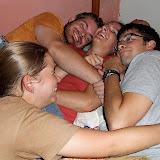
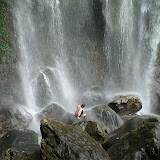
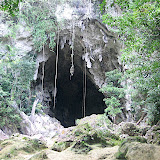
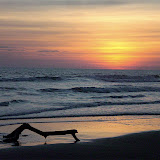

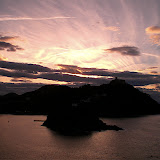


0 Comments:
Post a Comment
<< Home